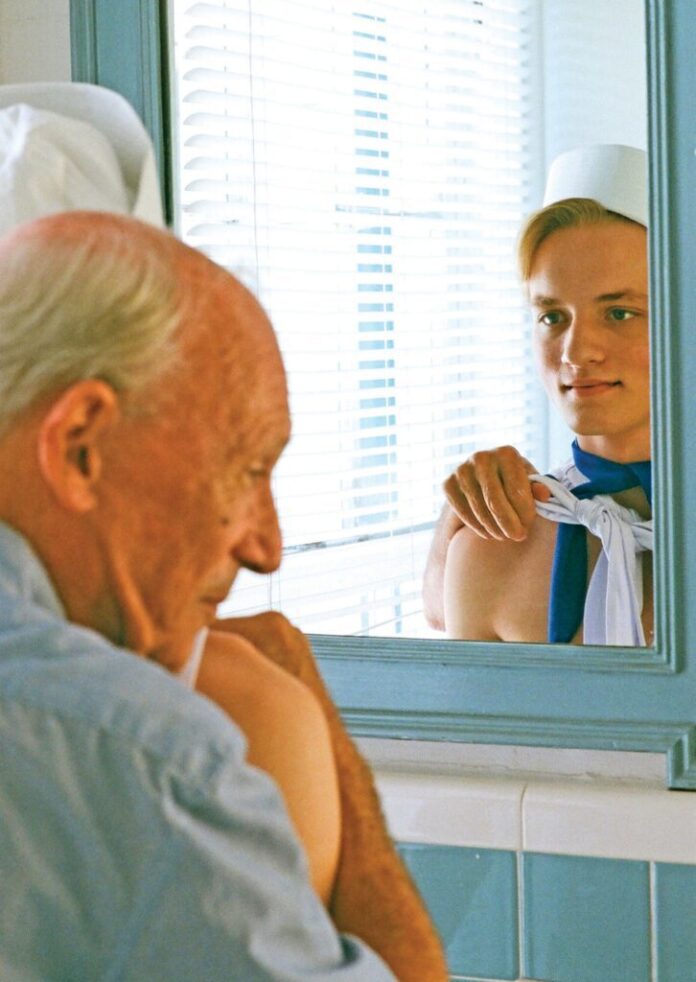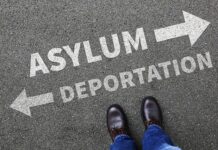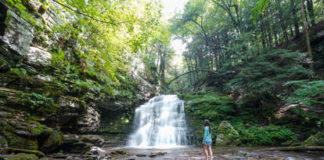
Photographer Matthew Leifheit’s latest exhibition will focus on Robert the Doll. It will be at The Studios of Key West. PHOTO BY MATTHEW LEIFHEIT
Matthew Leifheit is reimagining Robert the Doll as a queer story for his exhibition this November at The Studios of Key West (Nov. 3-23).
The photographer came up with the concept during his residency on the island when he participated in a ghost tour. He recalled, “…I took a ghost tour with the other residents and we were told the story of Robert the Doll, that of an aging man carrying around an effigy of his younger self. This sounded like a really gay story to me.”
Robert is a cloth doll made by Steiff that belonged to artist Robert Eugene Otto. The doll is said to be haunted. The doll is on display at Fort East Martello.
In translating the story into photographs, the artist examined some of the kinds of historical trends of relationships in the gay community. Leifheit’s photographs have shown internationally and previously appeared in publications including Artforum, The New York Times and The New Yorker. He also is the founder and editor-in-chief of MATTE Magazine, which supports emerging artists.

Matthew Leifheit says the idea for a photography exhibition themed to Robert the Doll came about during an artist residency at The Studios of Key West. PHOTO BY SHALA MILLER
I looked at some of your Key West photographs and could not immediately tell the location. Does that usually mean the artist has constructed a unique narrative or just steered clear of the obvious?
Matthew: I have been photographing tourists in Key West since 2014, but never really showed the landscape or architecture. Part of that is that it seems like well covered territory. But for Robert the Doll, I was fairly specific about the locations I chose. Some of them are Key West landmarks like Fort Zachary Taylor or Truman’s Little White House. Others are related to the island’s history as a gay travel destination and site of queer heritage, like photos staged at a house formerly owned by the poet James Merrill. The house where the real Robert the Doll lived, which is directly across the street from the gallery, is also a location. But all of the pictures revolve around a sailor doll character I created in collaboration with a local drag performer, Nathan Strange.
What sort of conversations did you have in your head with this character while creating them?
Matthew: My version of Robert is in conversation with a history of gay sailor iconography, like the fashions of Jean Paul Gaultier, the drawings of Jean Cocteau or the movie “Querelle.” But the way we styled the character is much more effeminate than the butch “trade” this archetype usually celebrates. The idea came about during an artist residency at The Studios of Key West, when I took a ghost tour with the other residents and we were told the story of Robert the Doll, that of an aging man carrying around an effigy of his younger self. This sounded like a really gay story to me. The next day, I found a gay sailor costume in a lingerie store on Duval Street and met Nathan, and in some ways, it felt like fate. In translating the story into photographs, we talked on set about the fetishization of twinks, and the kind of May-September relationships that are so common in the gay community. Conjuring this character in the setting of Key West also gestures towards a historical relationship between the military presence on the island and its gay culture, which is something people don’t want to talk about.
Why do you think even in Key West people do not want to talk about that relationship?
Matthew: Because of homophobia! Paul Cadmus’ painting “The Fleet’s In” was censored by the Navy in 1934 partly because it showed a brazenly effeminate man flirting with a sailor. Those attitudes about effeminacy or homosexuality being dishonorable are still prevalent in our culture.
Is that the theme you expect viewers to pick up on the most or does the exhibit feature dark nods to the supernatural lore of Robert the Doll?
Matthew: It’s just one thing people could see, and I hope there are many ways to read the work. I love that ghost tours will be stopping outside the gallery at night along their route, and tourists will encounter my retelling of the story in the same space as their tour guide’s. There are so many different versions of the details of Robert’s story depending on who is telling you or what you read. I am happy for mine to be the only gay one. Perhaps the relationship my work has to the actual paranormal object of Robert the Doll is one of deference, because some of his paranormal powers have to do with photography. He evaded being photographed for many years, and now the guides at the East Martello Museum, where he is on display, instruct guests to ask his permission and wait for a response before taking Robert’s picture, lest he might curse you. I went, I asked, and I didn’t feel he would give me permission and I respected that. So, the actual Robert doesn’t appear in my show. You’d have to go see him yourself. However, Nathan Strange will be performing live at the opening of my exhibition, propped up in a chair. Visitors will have to ask his permission to photograph.
In all the thousands of photographs you have personally taken and the scores featured professionally, did you ever have an inexplicable shot? An image that in hindsight defied odds or proved strange?
Matthew: Yes absolutely, I think much of my process is chasing that kind of image. Waiting for something inexplicable to happen in a photograph that makes it more special or strange or challenging than the thousands of images we are bombarded with all the time. Sometimes it’s a light condition or an expression on someone’s face, or something you couldn’t have predicted happening.
Is there one that stands out from your earlier work?
Matthew: There is a picture in my recent book, “To Die Alive,” published this year by Damiani, of a beach at night where two nude figures embrace as a wave is about to break over their huddled bodies. While taking that picture, my lights actually washed away into the ocean, which gives it a weird glow. One thing photography can do well is to catch something that could never be precisely recreated.
Do you like the bits of chaos that technology and natural environments introduce to shoots? Do you wish there was more?
Matthew: Yes, I like that element of unpredictability working in the real world! And working real people you never really know what you are going to get. My best work comes out of uncontrollable situations. It also tends to come from somewhat unwieldy camera technologies. For this work, I was using a Crown Graphic camera which uses 4- by 5-inch sheets of film. The process of using analogue materials also amplifies the element of chance, primarily because you can’t see the pictures as you’re taking them.
Does Key West strike you as having many of those unpredictable qualities especially for photography and personal experiences?
Matthew: Yes absolutely. It’s great for photographs because the light is always changing. In terms of personal experience, the island always provides something unexpected.
When people describe Key West as a gay city, what do they really mean by that? Do you agree?
Matthew: Since the 1940s, Key West has been one of the most important cities for gay people in America. Part of the draw was its remoteness; places like Provincetown, Fire Island and Palm Springs similarly benefited from geographic isolation when people could not live openly in many other parts of the country. In the 70s, gay tourism helped revitalize the island’s economy and more than 30 gay and lesbian guesthouses existed. Today there are only two or three, and family cruise ship tourism has pushed the gay businesses into discreet pockets. AIDS also had a lot to do with that decline, as well as cheaper gay tourism that developed in Fort Lauderdale. However, it’s still a place that attracts residents who want to live differently than others, and that includes a lot of queer people. In my experience, it is a place that welcomes freaks and promotes all kinds of self-expression.
You have a print publication, you’ve studied the academia, and you made a name for yourself in photography. What do you hope to get out of this show at The Studios?
Matthew: Yes, my publication, MATTE Magazine, was founded in 2010 to support emerging artists in photography. I love any chance to share my work with people in a physical space because it presents so many different possibilities than a publication does either in print or online. The gallery at The Studios is the ideal place to show this work because of its proximity to Robert’s house, and I am excited to share this work with people in Florida where it was made.
“Robert the Doll Exhibition” is open Nov. 3-23. Opening night 6 p.m. Nov. 3. It’s at The Studios of Key West, 533 Eaton St., Key West. Free admission. Info: 305-296-0458 or tskw.org. ¦







